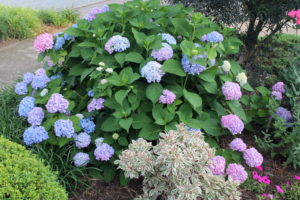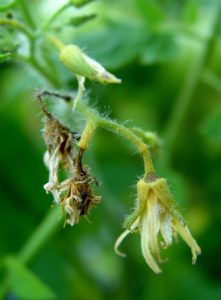Plants Doing Some “Catching Up?”
July 4th, 2017
Every growing season brings some good things and some not-so-good things. So far this year, it’s been mostly good.

One of my Endless Summer hydrangeas looking better than it has in 4 years. Is it doing some catching up?
The end of June was especially impressive… 2 inches of rain, then four beautiful, sunny days in the 70s. It doesn’t get much better weather-wise than that for gardeners.
I’ve heard a few people say they can’t remember a year when the spring-blooming trees bloomed so nicely. I agree. It was a stellar show by the redbuds, crabapples, magnolias, stewartias and especially the dogwoods. (Read my earlier post on our “Dogwood Comeback.”)
Lately, I’ve been hearing the same thing about this year’s hydrangea bloom. One fellow asked me what was up with them because they were putting out such extraordinary blooms.
My theory is that our woody plants might be doing a little “catching up.”
Some of them have had a hard time the past three seasons. First by those back-to-back “polar vortex” winters that killed buds and whole borderline-hardy plants and then last year by a winter that got too warm too soon, only to have spring nights in the teens kill prematurely developed flower buds.
I was afraid we were heading down the same path this year when our temperatures nearly hit a mind-boggling 80 degrees in February. It stayed abnormally warm for a couple of weeks, too. Then we got a blast of cold in early spring.
Apparently, the warm/cold/warm treatment wasn’t enough to cause as much damage this year.
A telltale plant is the bigleaf hydrangea (H. macrophylla), that favorite home-garden shrub with the softball-sized round flowers of pink or blue (depending on soil acidity).
It’s a shrub with fairly cold-sensitive flower buds. Go much below zero in winter or run into a late freeze in early spring after the buds have started opening, and the buds die. That means few or no flowers.
That’s been the case for three years now with macrophyllas. The display hasn’t been good at all. But these past two weeks have been hydrangea heaven.
Maybe the show just seems impressive because it’s been years since we’ve had a good one, but I think it’s more than that.
It could be that hydrangeas are flowering like crazy to make up for their poor performance. That sounds absurdly people-like, but woody plants often do flower and fruit in cyclical patterns. (Think fruit and nut trees in particular.)
Since flowering is a reproductive function that plants do to keep their family going and not to impress us, it’s not unusual to see big-seed years follow poor-seed ones.
Flower and ensuing seed production takes a lot of energy, so if a tree has thrown out a lot of viable seed one year, it makes sense to conserve energy by backing off the next year. Conversely, if reproduction got stunted somewhere along the way one or more years, the tree attempts to ensure survival by ramping up flowering and seeding in the current year.
Whether that explains our heightened performance this year or not, enjoy the bloom.
I hope you’re also enjoying harvest from the vegetable garden by now. I picked my first ripe tomato last week (a ‘Chef’s Choice Orange’ grown under a Wall ‘o Water plant protector), and I’ve had good harvests of peas, cabbage and especially head lettuce. It’s been my best spring ever for head lettuce.
I’ve been getting questions about blossoms dropping off of some people’s tomato plants, though. I think that was due to poor pollination when the weather zoomed up to 90 right before the late-June rain.
Tomato pollen loses viability when daytime highs hit the upper 80s. So that brief heat wave could explain it. You should be seeing tiny fruits forming at the base of tomato flowers now, following the near-perfect end of June.
Something that isn’t going to work itself out is the dreadful performance in onions. About 90 percent of my onions have keeled over and rotted this year, which is unusual because onions have always been a bullet-proof plant in my garden.
I thought it was just me, but then I started getting questions from others. The prevailing guess was that onions were rotting in wet soil.
Since I grow in raised beds with well drained, compost-enriched soil, I doubted simple rotting was the explanation. When I looked more closely, I found tiny white maggots in the mushy bulbs-to-be.
Our part of Pennsylvania is just now starting to see an infestation of a new onion bug called the onion leafminer. It starts out causing stunted or curling leaves that have punctures up and down the leaf blades. The punctures are where the adult females have laid eggs.
The larvae are tiny maggots that work their way down the leaves and into bulbs, resulting in rotting from the feeding damage and from disease organisms that enter through the bug-caused wounds. (More on this from Penn State Extension at http://ento.psu.edu/extension/vegetables/pest-alert-allium-leafminer.)
My damage didn’t quite fit the leafminer mold and instead looks to be an attack of the old-fashioned onion maggot. Adult flies lay eggs at the base of onion foliage, and the hatched larvae burrow down into the swelling underground bulb.
That’s what I think my onions have. If you don’t see those punctured leaves but are seeing maggots, you probably have what I have.
There’s not much that can be done at this point either way. Covering the plants with a floating row cover to exclude the egg-laying adult flies is the best strategy.
All I can figure is that it must have been a good season for onion maggots as well as gardeners.









